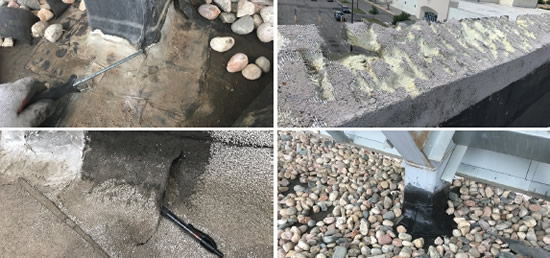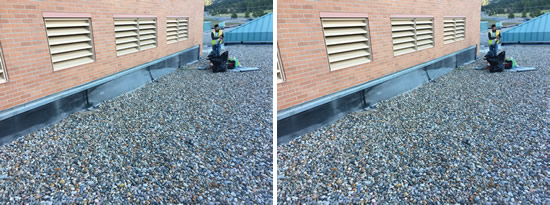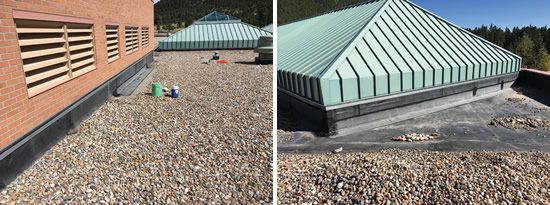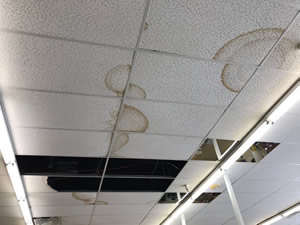Is There a Better Re-Roof Protocol?

PHOTOS COURTESY OF NATIONS ROOF OF COLORADO
It is time to prepare for the season of re-roofs when most of the schools are unoccupied and work on the roof can be done no matter how smelly or loud without disturbing instruction.
The real point of re-roof is useable life extension. Ty Stranger-Thorsen, president of Nations Roof of Colorado, a strong advocate of aggressive preventive roof maintenance, says any re-roof project should begin with an annual inspection protocol. Unlike the maintenance of mechanical systems, which tend to receive regular attention, the preventive maintenance of the roof is often forgotten until it begins to leak. An aggressive preventive maintenance program is the best defense against wasting scarce resources. That program should include an annual inspection of each roof in the inventory, not just the ones with problems.
This can be done with in-house personnel or by a trusted roofing professional. The inspection will help you identify what work needs to be done and where it should be placed in priority. The annual walkthrough can also accomplish the basic roof maintenance like clearing roof drains and attending to pitch pockets.
If the roof is under warranty, most if not all manufacturers require the work on the roof be done by a contractor certified by the manufacturer. Many also require a yearly inspection log be maintained. Just because a roofer has installed the membrane does not mean you are required to use that company for the life of the warranty.
Manufacturers usually require the installer to maintain the roof for a period of up to two years. After that time, if the owner is dissatisfied, they may be free to hire another company as long as they are certified by the manufacturer. “It is amazing to me how many owners stick with the original installer although they are dissatisfied with their customer service, thinking they have no other option,” says Stranger-Thorsen.
Since you must discover what the existing conditions are, the next step for a roof being considered for improvements should be an infrared or IR scan. By showing areas of moisture-saturated insulation, the scan helps determine the extent of the work to be done. Since water normally does not drop straight down but tends to travel once inside the structure, it is rare that the leak inside is directly below the leak in the perimeter or membrane. The scan helps to determine the actual locations of the leaks.
Roof membranes fail in a variety of ways as they age depending upon their material. If the insulation has not been completely soaked, there may be several options to extend the useable life of a roof without completely tearing off the existing roof membrane. An ethylene propylene diene monomer (EPDM) rubber membrane shrinks over time, but may not deteriorate enough to be replaced. Because it shrinks it tends to pull away from the perimeter and strain the seams. A re-roof in this case involves cutting the base flashing and adding about five feet of new membrane around the perimeter and resealing the seams.
A modified bitumen 3- or 4-ply roof can be re-roofed with a perimeter enhancement and a fluid-applied coating or cap sheet to extend its useable life. Unfortunately, there are fewer options for a thermoplastic olefin (TPO) of polyvinyl chloride (PVC) membrane because as these membranes age, they develop pinholes in the membrane. Stranger-Thorsen says he has had success with a fluid applied coating in some cases. In others, there is no choice but to replace the membrane.


PHOTOS COURTESY OF NATIONS ROOF OF COLORADO
Roofs never seem to fail in good weather. The unusual inclement weather events this fall and winter have created some challenges for facilities professionals. There were many 60-mil TPO membranes over rigid insulation in the Denver area damaged by last year’s hail storms. A heavier membrane or a protection board substrate may have performed better in those circumstances.
The heavy snowfalls and repeated freeze thaw cycles this winter caused ice damming for those sloped roofs that did not have heat strips in the gutters. Record snow accumulation meant some schools had to clear snow from low slope roofs that were not designed to carry that kind of load. Even if there are no apparent leaks, the best practice is to inspect the roof before and after such severe weather events.
For both new roofing and re-roofing, a quality installation is the key to a roof envelope that will keep the building in the dry. When all is said and done, Stranger-Thorsen states, “There can be no substitute for the right membrane placed on the appropriate substrate.” He has found that competitive bidding sometimes leads to roofers using too thin a membrane, not enough insulation, or in some cases the wrong membrane altogether in order to develop a more competitive bid.
There is no single membrane that is the best for every circumstance in every area of the country. Where heating is the major energy use, a dark membrane may make sense. If air-conditioning is the main concern, then a cool roof is a better option. He recommends working with a trusted roofing professional to determine the right membrane and specifications for the installation.
Once a product is selected and specified, check with the manufacturer to verify that the details (slope, attachment, flashing, etc.) are what they recommend. If a substitute material is acceptable, specify its pertinent details as well. Where procurement regulations permit, he also advises a weighted procurement process instead of low bid. This kind of selection process allows the purchaser to identify the important issues of the bid (including price) and assign numerical weights to them to create a selection process that delivers the kind of product and installation that meets their needs.

PHOTO COURTESY OF NATIONS ROOF OF COLORADO
Just as there is no roof membrane that solves each and every problem, there is no single re-roof methodology that will produce a perfect re-roof project every time. Unlike a new roof installation where you have the luxury of a brand new deck upon which to work, the re-roof often involves existing conditions that may or may not be apparent. A proactive approach is the best defense against bad assumptions and costly surprises.
A protocol that optimizes resources involves knowledge of the existing materials involved, how they age, infrared scanning prior to decision-making, and an aggressive preventive maintenance program using in-house expertise or a trusted roofing professional.
In order to optimize your resources, it should be understood that every re-roof is not a complete tear-off and every 20 year old membrane is not in imminent danger of failure. Replace only that which has failed and rejuvenate that which has useable life. The re-roof protocol should match the existing conditions. Even though everybody knows that the lifespan of a commercial low slope roof is 20 years, management guru Peter Drucker often said, “What everybody knows is probably wrong.”
This article originally appeared in the School Planning & Management March 2018 issue of Spaces4Learning.